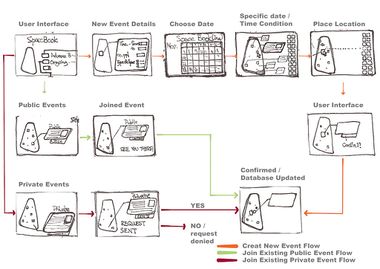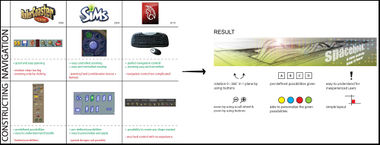project C:ALL
INTERFACE
CONCEPT
The interface is the medium used by the users of the social community to interact with each other, organize and engage in activities in the real world. The interface is an online website and smartphone application. Stressing the online aspect will create the opportunity of an unlimited number of users having access to the interface.
RESEARCH
The research has looked at several software applications and games which showed the different possibilities and chances the interface would give the user.
Several general conclusions came out of this analysis:
- an easy and understandable interface which has limited possibilities in the program is more appealing to the general user-public
- the average user prefers not to spend a lot of time always customizing the profile and prefers already-made configurations
- an interface which offers full control requires a lot of experience and is more difficult to learn for the average user
Every interface analyzed explore the following functionality:
- rotation (0-360) in 1 plane by the use of a button
- zooming in and out by use of the scroll wheel
- given pre-defined possibilities
- opportunity to make user - profiles
- generally simple layout.
These parts are integrated with the Spacebook interface design.
References
VALIDATORS
Design Proposal
The design of the interface will have the following functionality:
- zoom in on the 3D of the location by using the scroll wheel and a zoom button
- rotate around vertical axis of the location by using the given buttons
- option of customizing ready-made profiles
- a clear overview of what is happening on the site
- a direct relation between the input of the user and the (on the website) visible output
- simple layout for legibility and ease of use
Three interface types of Spacebook are created: the standard user interface, the advanced user interface and the administrator interface.
To book a space via the standard Spacebook interface is done with only a few easy steps:
1) After the user selected his preferred day and time an updated 3D layout of the location appears on the right side
of the screen.
2) The user fills out only two criteria: the activity type and the amount of people participating. Then on the left
side of the screen the standard solution appears.
3a) Three options to personalize the space are given: completely flat (open), a flat roof, or a dome structure. The
output is always directly visualized on the left side of the screen.
3b) Working in library mode gives the user the possibility to select space setups made and saved by other users. This
principle works via a popularity poll (most popular spaces at the top).
4a) The user has the possibility to link his activity to another activity by sending a link request.
4b) When the user is content with the setup he presses the save button.
The advanced Spacebook interface gives the user more options to create his ideal space and works as follows:
1) After the user selected his preferred day and time an updated 3D layout of the location appears on the left side
of the screen.
2) By dragging his mouse over the grid, the user selects the preferred area for his activity. The output
automatically updates on the right side of the screen.
3) The user has the possibility to personalize his entire space. The standard setting for the curve that defines the
space is 'medium', but the user has the possibility to change the curve to 'flat', 'small' or 'large'.
4a) The user can also select more grid cells, directly next to his already defined space. This also appears on the
right sight of the screen. Together with his earlier defined space it starts creating an ensemble.
4b) The user can then rotate around his created ensemble, and change the curve of each space individually.
5) When a user would like to have a space made out of several curves in one row, he uses the 'division' button the
determine the beginning and ends of each curve. Each curve can be individually changed to the preffered setting (flat, small, medium or large).
6) The created space will be saved when the user is done and added to the library.
The administrator Spacebook interface is created for the management of the physical Spacebook site (TU Delft?). The
administrator has the right to overrule any activity at any time for maintenance work or other jobs. He can overrule the system by selecting the cells that
will be inoperable at a certain time frame. There is also a administrator library where settings for maintenance jobs and spatial criteria are stored.









